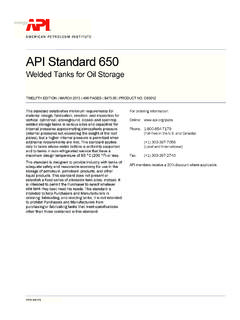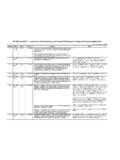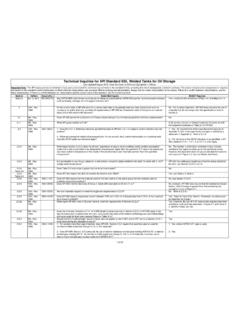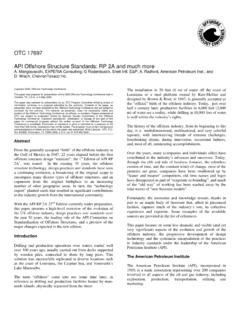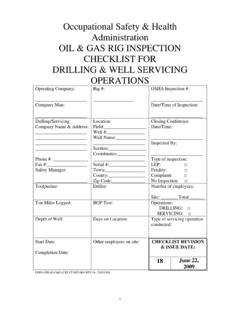Transcription of Vertical Cylindrical Storage Tank Calibration Technologies ...
1 Vertical Cylindrical Storage Tank Calibration Technologies and Application Srini Sivaraman SK Japan March 2012. API Conference & Expo Singapore 2012. 1. Calibration Overview - 1. Process by which the volume in a tank in relation to the liquid height (up to maximum fill height) is established The diameter of the courses is determined by field measurements using following Technologies Reference Standards: API Chapter A: Manual API Chapter B: Optical Reference Line Method (ORLM). API Chapter C: Optical Triangulation Method (OTM). API Chapter D: Electro Optical Distance Ranging Method (EODR). API Standard 2555: Liquid Calibration 2. Calibration Overview - 2. All new tanks must undergo Calibration Have access to internal for accurate deadwood determination Datum plate (reference plate at the bottom) flatness and level check and correction as necessary Calibration after successful hydrostatic test All tanks in service must undergo recalibration or re computation Recalibration at set frequency or after repair Either set by customs or local regulations General informative guidelines per API Chapter A.
2 Re computation only under certain conditions 3. Frequently Asked Questions Do you have to empty the tanks for re Calibration NO. Can you calibrate the tank at any liquid level Yes Can you calibrate the tank when the tank is moving (receiving or discharging). No, you cannot calibrate the tank while the tank is in motion. The tank level must be steady and no movement in and out of the tanks Does product temperature impact volume Yes. It results in expansion of tank shell wall and the additional volume can be significant Can Calibration be undertaken over the insulation No, not for custody transfers and inventory 4. Frequently Asked Questions Can you calibrate the tank when the tank is full of water for hydro test Yes . Once the test is completed you can calibrate the tank full of water, de-stress the tank to zero stress condition and re-stress the tank for the actual gravity of the product What is the impact of gravity in tank Calibration For a given liquid level the hydrostatic pressure is a function of gravity and this results in tank expansion.
3 If not accounted for it could impact the tank volume significantly depending on diameter and thickness of shell Also FR must be compensated for buoyancy that is function of gravity Gravity of course is needed for VCF. Do you need traceability for working tape Calibration Working tape is calibrated by master tape and master tape is calibrated per National Standards 5. Calibration Process Parameters Following operational parameters must be supplied by the tank owners to the Calibration contractor Product Temperature Product Gravity Roof Leg Position for FR ( Critical Zone: Figure 1). Zone needed for FR to float fully from rest position (no custody gauging in this zone). Ambient Temperature Maximum Fill Height ( depends on safety rules). These must not be decided by or assumed by the Calibration contractor 6. Note: Critical Zone Position varies with FR position Roof Legs CZ. Floating Roof CZ.
4 FR in Maintenance Position FR in Operating Position Floating Roof Position Figure 1 7. Calibration by Manual Method Manual Method API Chapter Often is referred to as the Referee Standard (basis for all other methods). Circumference measured with a working tape at various courses Working tape is Calibrated against a master tape and applicable tension determined for actual application Master tape readings generally are at 68 deg F. Tape is maintained physically in perfect contact with shell Tape is maintained in horizontal plane Stroke the straps two or thee times to ensure perfect contact with the shell Single strap or multiple straps may be used Multiple straps with a smaller length tape are preferred as they are easy to handle They are easy to maintain control, contact with shell and horizontality All circumference measurements are external Tank shell surface must be clean 8.
5 Field Measurements-1. Calibration in the field involves following physical measurements Circumference measurement of each course (Figure 2). Using working tape calibrated with appropriate tension Multiple straps or single strap at each course Typical tape length of 100 ft may be used Number of Straps required = * D( ft ). 100( ft ). Plate Thickness Measured ultrasonically all around in each course (8 to 12 data points) and averaged for each course Diameter Computed from the measured circumference and the thickness 9. Note: Ideally scaffolding fixed or portable needed to maintain tape in contact with shell C. 48 to 64 ft A. B. AB, BC, CA : Three straps (An example). A to A : Single Strap (heavy). Multiple Straps easier to handle Manual Calibration : API Chapter Figure 2 10. Field Measurements-2. Reference height and reference gauge point (Figure 3). Critical component of Calibration For new tanks easily established For old tanks the bottom access to datum plate may not be possible as bottom maybe filled with solid sludge or other foreign materials If access is not available one should not try and measure RH but use the RH from previous Calibration table Gauge point is the point from which gauging should be undertaken The gauge point should be clearly marked on the stilling well Critical Zone (Figure 1).
6 On empty tanks roof leg position can be verified physically On tanks in service , information may be taken from the last tank Calibration table Typically this is in the range of 6 to 12 in but could be as high as 18 in depending on FR design 11. Field Measurements-2. Deadwood All internal piping and other structures inside are physically measured and their volumes distributed vertically from the datum plate This is necessary to subtract the volume of the deadwood as tank table is developed (volume Vs height). This is possible only when entry is permitted into the tank, if not it should be taken from the most recent Calibration data FR Weight During Calibration FR weight is collected either from old table data or physically measured and computed. But computation could potentially carry large uncertainty Number of welding rods that are used in the FR fabrication must be taken into account or else could understate the FR deadweight Best obtained from the fabricator and documentation on file maintained for all future Calibration 13.
7 Field Measurements-3. Maximum Shell Height This height is measured and documented as part of the development of the tank table Measured externally from the base Maximum fill Height Depends on local conditions Earthquake zones ; 4 to 6 feet below the top rim Others limited by FR height Bottom Calibration Tank bottom could be flat, cone up or cone down Tank bottoms are measured by physical survey when entry is allowed Tank bottoms may also be calibrated with liquid (water). When in service the zero gauge volume is copied from old tables Zero gauge volume is the volume below the datum plate Tilt Measured optically or manually by plumb line 14. Capacity Table Development The capacity table is simply a table that gives the volume of the tank at any given height In the development of the table following corrections should be applied FR buoyancy correction Tank tilt correction Hydrostatic correction Shell temperature correction Master tape correction Working tape correction Other correction such as tape rise 15.
8 Corrections 1. FR Buoyancy Correction Correction is based on gravity of the product and FR weight FR correction (volume units) must be subtracted from the total volume at any given level as long as FR is fully floating In critical zone the FR correction is distributed over the range of the zone Below the critical zone FR correction is zero Tank table carries the base FR correction for a given gravity and incremental correction for variations in base gravity Tilt Correction No correction needed when tilt is less than 1 in 70. Tilt correction is requires when tilt exceeds the above value Maximum tilt should be less than in 100. 16. Corrections -2. Hydrostatic Head correction Hydrostatic head (liquid pressure) causes expansion of the tank shell Additional volume from pressure expansion may be as high as depending on plate thickness Expansion function of plate thickness and gravity for a given tank API A provides detailed procedure for calculating the incremental volume and the total volume for pressure correction The additional incremental and total volume is generally included in the capacity table for a given gravity of the product Variation in gravity of +/- 5 deg API will have negligible impact on the computed volume If the gravity changes by more than 10 deg API the table must be rechecked 17.
9 Corrections - 3. Shell Temperature Expansion Correction Shell expands due the combined effect of product and ambient temperature The impact on total volume could be and higher The shell temperature determination equation has been modified from the old API Standard 2550. It is no longer the mean of ambient and product temperature In the new equation product temperature dominates tanks which are insulated, the shell temperature equals product temperature The temperature expansion factor may be included in the main capacity table for a give product and ambient condition or The capacity table may be established at 60 deg F or 15 deg C and the shell temperature expansion factor may be applied externally for each batch received or discharged from the tank with actual field temperatures The capacity table may also be accompanied by a temperature expansion factor table when the capacity table is at 60 deg F.
10 18. Corrections - 4. New Shell Temperature Equation 7 * TL + TA. TS =. 8. TL = Liquid Temperature TA = Ambient Temperature Master Tape Correction Tape carries Calibration to 68 deg F. Measured lengths should be corrected to 60 deg F. Other Corrections Tape rise correction, if needed, should be applied 19. Recalibration Frequency Informative Appendix in API Chapter A provides guidelines Recalibration is required on all tanks if internals are modified Recalibration may also be mandated by local regulations or customs Recalibration is required if the tank bottom repair work is undertaken 5/15 rule for tanks in Custody Service Bottom course verified once every 5 years for diameter, thickness and tilt Variations in D, t, and tilt (from previous Calibration ) are computed and impact on volume determined If variation in volume is in excess of recalibration is recommended If variation in volume is within , 5 year verification is continued until 15.



